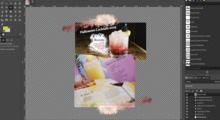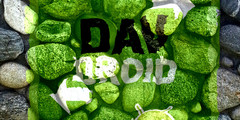Scanned negatives, moire patterns and GIMP?
This discussion is connected to the gimp-user-list.gnome.org mailing list which is provided by the GIMP developers and not related to gimpusers.com.
This is a read-only list on gimpusers.com so this discussion thread is read-only, too.
| Scanned negatives, moire patterns and GIMP? | Keith Purtell | 04 Dec 22:55 |
| Scanned negatives, moire patterns and GIMP? | Steve Kinney | 04 Dec 23:59 |
| Scanned negatives, moire patterns and GIMP? | Liam R E Quin | 05 Dec 01:11 |
| Scanned negatives, moire patterns and GIMP? | Keith Purtell | 05 Dec 17:07 |
| Scanned negatives, moire patterns and GIMP? | Keith Purtell | 05 Dec 20:34 |
| Scanned negatives, moire patterns and GIMP? | Thorsten Stettin | 06 Dec 11:29 |
| Scanned negatives, moire patterns and GIMP? | Pat David | 12 Dec 17:30 |
Scanned negatives, moire patterns and GIMP?
I recently had some 20-year-old color negatives scanned. About half the
scans had moire patterns. My understanding is that moire (in this case)
would be caused by contact between the glossy back of the negative and
another flat object such as a glass plate. When I went back to the
photography service, they told me their technician had reported the moire
was because "the negatives are really old." Well yes but they've been
stored in dry archival conditions and are not visibly damaged. They said
they'd try again.
If they can't resolve this, what are my chances of solving the problem
with GIMP? I tried a few of the existing filters without visible results.
My first Google searches haven't turned up a good detailed tutorial on
moire removal.
EK
Scanned negatives, moire patterns and GIMP?
On 12/04/2014 05:55 PM, Keith Purtell wrote:
If they can't resolve this, what are my chances of solving the problem with GIMP? I tried a few of the existing filters without visible results. My first Google searches haven't turned up a good detailed tutorial on moire removal.
I don't think that's possible. If I understand the problem, the moire effect is intensive, global noise with continuous variation in scale and contrast, resulting from superimposing a slightly out of alignment shadow or reflection on the image content. I don't think any filter is likely likely to be able to distinguish that kind of noise from image content - without a perfect copy for comparison, which of course ain't relevant here.
Hopefully the folks who failed on the first try will succeed on the second, otherwise, I would try someone else. They should have kept trying to fix it and/or admitted to failure, instead of delivering useless junk as finished work.
:o/
Steve
Scanned negatives, moire patterns and GIMP?
On Thu, 4 Dec 2014 15:55:15 -0700 "Keith Purtell" wrote:
I recently had some 20-year-old color negatives scanned. About half the scans had moire patterns. My understanding is that moire (in this case) would be caused by contact between the glossy back of the negative and another flat object such as a glass plate.
Any good transparency scanner comes with a mount for holding the slides away from the glass.
If they can't resolve this, what are my chances of solving the problem with GIMP? I tried a few of the existing filters without visible results. My first Google searches haven't turned up a good detailed tutorial on moire removal.
There's a G'MIC filter for it. But it depends on the exact nature of the pattern as to what's best. I get them when scanning colour books, because of the way the books are printed (it's actually unavoidable unless you use a "descreen filter" in the scanner driver, but better to do it in GIMP). For that, separating into layers and using gaussian blur is often best, but another possibility is to use wavelet decomposition and delete that high frequency layers. G'MIC has a filter to do that, too.
If you can share a sample I can have a better look.
Liam Quin - XML Activity Lead, W3C, http://www.w3.org/People/Quin/ Pictures from old books: http://fromoldbooks.org/
Scanned negatives, moire patterns and GIMP?
Thanks to you and Steve for this. I'll make a screen capture available when
I'm next at my regular computer.
On a related note; yes the long-range solution will be to get some kind of
access to a proper scanner.
-------- Original Message --------
I recently had some 20-year-old color negatives scanned. About half
the
scans had moire patterns. My understanding is that moire (in this
case)
would be caused by contact between the glossy back of the negative and another flat object such as a glass plate.
Any good transparency scanner comes with a mount for holding the slides
away from the glass.
If they can't resolve this, what are my chances of solving the problem with GIMP? I tried a few of the existing filters without visible
results.
My first Google searches haven't turned up a good detailed tutorial on moire removal.
There's a G'MIC filter for it. But it depends on the exact nature of the
pattern as to what's best. I get them when scanning colour books, because of the way the books are printed (it's actually unavoidable unless you use a "descreen filter" in the scanner driver, but better to do it in GIMP). For that, separating into layers and using gaussian blur is often best, but another possibility is to use wavelet decomposition and delete that high frequency layers. G'MIC has a filter to do that, too.
If you can share a sample I can have a better look.
Scanned negatives, moire patterns and GIMP?
Here's a link to one portion of the image:
http://i.imgur.com/6RaV68i.jpg
On 12/4/2014 7:11 PM, Liam R E Quin wrote:
If they can't resolve this, what are my chances of solving the problem with GIMP? I tried a few of the existing filters without visible results. My first Google searches haven't turned up a good detailed tutorial on moire removal.
There's a G'MIC filter for it. But it depends on the exact nature of the pattern as to what's best. I get them when scanning colour books, because of the way the books are printed (it's actually unavoidable unless you use a "descreen filter" in the scanner driver, but better to do it in GIMP). For that, separating into layers and using gaussian blur is often best, but another possibility is to use wavelet decomposition and delete that high frequency layers. G'MIC has a filter to do that, too.
If you can share a sample I can have a better look.
Scanned negatives, moire patterns and GIMP?
Am 05.12.2014 um 21:34 schrieb Keith Purtell:
Here's a link to one portion of the image:
Try this via G'MIC: https://www.youtube.com/watch?v=3137dDa6P4s
I hope this helps. :-)
On 12/4/2014 7:11 PM, Liam R E Quin wrote:
If they can't resolve this, what are my chances of solving the problem
with GIMP? I tried a few of the existing filters without visible results.
My first Google searches haven't turned up a good detailed tutorial on moire removal.There's a G'MIC filter for it. But it depends on the exact nature of the pattern as to what's best. I get them when scanning colour books, because of the way the books are printed (it's actually unavoidable unless you use a "descreen filter" in the scanner driver, but better to do it in GIMP). For that, separating into layers and using gaussian blur is often best, but another possibility is to use wavelet decomposition and delete that high frequency layers. G'MIC has a filter to do that, too.
If you can share a sample I can have a better look.
_______________________________________________ gimp-user-list mailing list
List address: gimp-user-list@gnome.org List membership: https://mail.gnome.org/mailman/listinfo/gimp-user-list List archives: https://mail.gnome.org/archives/gimp-user-list
Lao-Tse sagt: Nichtstun ist besser, als mit viel Mhe nichts zu schaffen. Und er sagt auch: Ich habe drei Schtze, die ich hte und hege. Der eine ist die Liebe, der zweite ist die Gengsamkeit, der dritte ist die Demut. Nur der Liebende ist mutig, nur der Gengsame ist grozgig, nur der Demtige ist fhig zu herrschen.
Scanned negatives, moire patterns and GIMP?
These are usually referred to as "Newtons Rings", and are from contact with the negative backing side being placed against the scanning glass. Liam is right that there are better negative holders to keep the physical negative away from the scanning glass to stop this from happening. A short term solution could also be to scan the negative with the emulsion side down (but be really, really careful you don't scratch it).
http://en.wikipedia.org/wiki/Newton's_rings
Unfortunately, a fourier transform won't solve the problem, as the pattern is circular in nature, and localized at the contact points (so a different problem than the neat solution provided by Thorstein's video).
On Sat, Dec 6, 2014 at 5:29 AM, Thorsten Stettin
wrote:
Am 05.12.2014 um 21:34 schrieb Keith Purtell:
Here's a link to one portion of the image:
Try this via G'MIC: https://www.youtube.com/watch?v=3137dDa6P4s
I hope this helps. :-)
On 12/4/2014 7:11 PM, Liam R E Quin wrote:
If they can't resolve this, what are my chances of solving the problem
with GIMP? I tried a few of the existing filters without visible results.
My first Google searches haven't turned up a good detailed tutorial on moire removal.There's a G'MIC filter for it. But it depends on the exact nature of the pattern as to what's best. I get them when scanning colour books, because of the way the books are printed (it's actually unavoidable unless you use a "descreen filter" in the scanner driver, but better to do it in GIMP). For that, separating into layers and using gaussian blur is often best, but another possibility is to use wavelet decomposition and delete that high frequency layers. G'MIC has a filter to do that, too.
If you can share a sample I can have a better look.
_______________________________________________ gimp-user-list mailing list
List address: gimp-user-list@gnome.org List membership: https://mail.gnome.org/mailman/listinfo/gimp-user-list List archives: https://mail.gnome.org/archives/gimp-user-list--
Lao-Tse sagt: Nichtstun ist besser, als mit viel Mühe nichts zu schaffen. Und er sagt auch: Ich habe drei Schätze, die ich hüte und hege. Der eine ist die Liebe, der zweite ist die Genügsamkeit, der dritte ist die Demut.
Nur der Liebende ist mutig, nur der Genügsame ist großzügig, nur der Demütige ist fähig zu herrschen._______________________________________________ gimp-user-list mailing list
List address: gimp-user-list@gnome.org List membership: https://mail.gnome.org/mailman/listinfo/gimp-user-list List archives: https://mail.gnome.org/archives/gimp-user-list
pat david http://blog.patdavid.net











